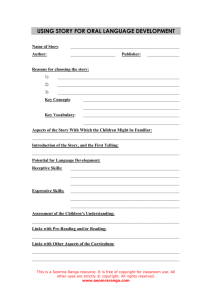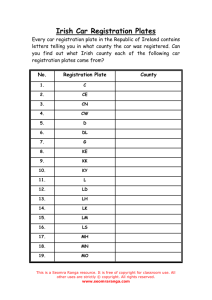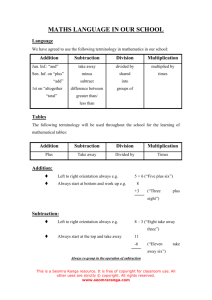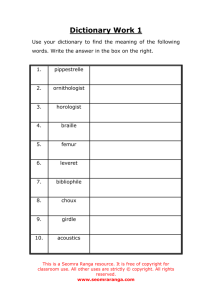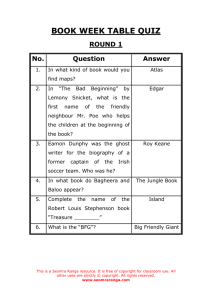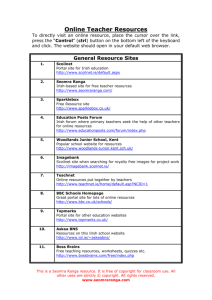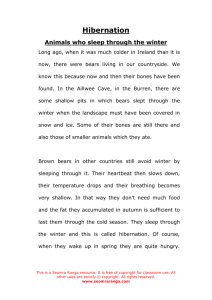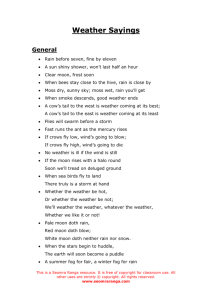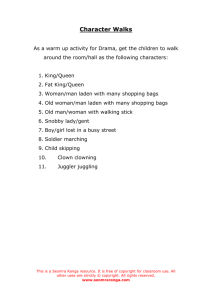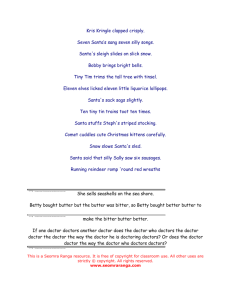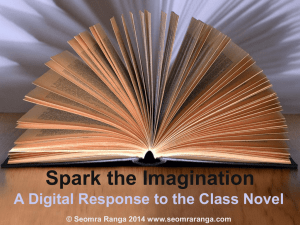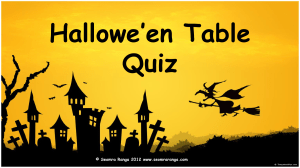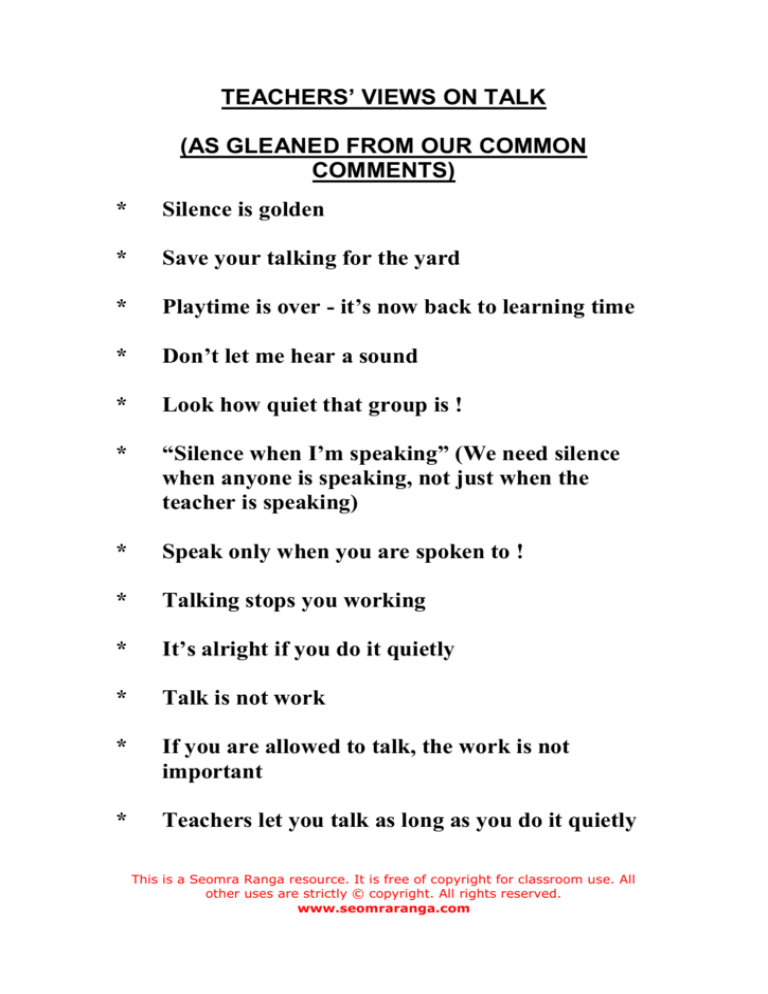
TEACHERS’ VIEWS ON TALK
(AS GLEANED FROM OUR COMMON
COMMENTS)
*
Silence is golden
*
Save your talking for the yard
*
Playtime is over - it’s now back to learning time
*
Don’t let me hear a sound
*
Look how quiet that group is !
*
“Silence when I’m speaking” (We need silence
when anyone is speaking, not just when the
teacher is speaking)
*
Speak only when you are spoken to !
*
Talking stops you working
*
It’s alright if you do it quietly
*
Talk is not work
*
If you are allowed to talk, the work is not
important
*
Teachers let you talk as long as you do it quietly
This is a Seomra Ranga resource. It is free of copyright for classroom use. All
other uses are strictly © copyright. All rights reserved.
www.seomraranga.com
TEACHER TALK
Most of the language used by teachers falls into
three categories: (The 3 I’s)
- Interrogation
- Instruction
- Information
INTERROGATION:
forms more than 60% of class interactions
conversations usually opened and maintained
by questions
INSTRUCTION:
gave meanings to specific situations
eg. “Line up”, “Put your hand up”
INSTRUCTION IN DISGUISE:
“Can you put you coat on now ?”
“There is a space over by the window”
(- complex language demanding an
understanding of the classroom)
INFORMATION:
usually given in response to a question by
the child
(least likely form of language to be
misunderstood by the child)
This is a Seomra Ranga resource. It is free of copyright for classroom use. All
other uses are strictly © copyright. All rights reserved.
www.seomraranga.com
CONCLUSIONS
1. The language used by teachers and
other adults in the early “educational”
environment has a pattern and
structure and meaning which is in
some important aspects specific to
the setting.
2. The frequent use of questions to draw
language from the child seems to
reassure the adult that
teaching/learning is taking place.
3. No special care was taken to check
whether the child had understood the
question, instruction or information.
4. The child’s response was often “made
to fit” the adult’s instruction.
- Maines and Robinson (1991)
“Teacher Talk”
This is a Seomra Ranga resource. It is free of copyright for classroom use. All
other uses are strictly © copyright. All rights reserved.
www.seomraranga.com
SUMMARY
1.
CHILDREN ARRIVE IN THE SCHOOL OR
PRE-SCHOOL SETTING WITH DIFFERING
EXPERIENCES OF LANGUAGE AND SPEECH.
2.
THERE IS AN ASSUMPTION THAT THE
“GOOD
TEACHING LANGUAGE” RESEMBLES
THE PATTERNS
COMMONLY FOUND IN MIDDLE-CLASS HOMES.
3.
TEACHERS DO A GREAT DEAL OF TALKING.
4.
TEACHER TALK INCLUDES A SET FOR MEANING
WHICH MAY NOT BE
UNDERSTOOD BY ALL PUPILS
AND WHICH IS SPECIFIC TO THE SCHOOL SETTING.
5.
TEACHERS ASK A LOT OF QUESTIONS.
6.
MOST OF THE QUESTIONS ARE CLOSED,
ALLOWING ONLY A RIGHT AND A WRONG
ANSWER.
7.
TEACHERS MAY DISREGARD CONVENTIONS
OF POLITENESS IN THE CLASSROOM WHICH
MAINTAIN THEIR POSITION OF POWER
AND
CONTROL.
- Maines and Robinson (1991)
This is a Seomra Ranga resource. It is free of copyright for classroom use. All
other uses are strictly © copyright. All rights reserved.
www.seomraranga.com
CLEAR SENDING OF VERBAL LANGUAGE
A: LISTENING SKILLS
1. Use the child’s name at the beginning of
any instruction/communication.
eg. “Paul, please come here.”
2.
Establish eye-contact before proceeding
and maintain during sending unless the
is required to look elsewhere, eg. at a
book.
3.
Stop talking and re-establish eye-contact
if attention is broken.
4.
Use touch, eg. hand on shoulder, to
maintain contact.
child
B: CLARITY
1. Do not give information outside the
“attention span.”
2.
Give clear, positive and full instructions.
3.
Avoid very brief sentences. The child may
not have tuned in to the language so add a
few neutral words to get the listening
going.
eg. “Now, go and do the next page.”
This is a Seomra Ranga resource. It is free of copyright for classroom use. All
other uses are strictly © copyright. All rights reserved.
www.seomraranga.com
4.
Avoid very long sentences which include
several pieces of information.
5.
Specify conditions of the task eg. the
beginning and the end, place etc.
eg. “Make the jigsaw until it is finished
and then bring it to me. Do it on your own
and sit at your table.”
C: POSITIVE QUALITY
Attention to clarity, confirmation that the
child is really listening and some use of
touch to maintain concentration may change
the quality of the message.
D: PERCEPTION CHECKING
If you have ensured that the message has
been sent correctly, you need to check
whether it has been received and
understood. This cannot be done simply by
asking the child whether he understands.
He probably doesn’t know what he doesn’t
understand so DO NOT ACCEPT A NOD
FOR AN ANSWER. try and ask the child
to tell you or show you what he thinks has
been agreed.
This is a Seomra Ranga resource. It is free of copyright for classroom use. All
other uses are strictly © copyright. All rights reserved.
www.seomraranga.com
E: CLARITY TRAPS
Teachers often use language which they
believe to be clear but which includes a
number of assumptions about a shared
meaning or understanding which the child
may not have. Most children learn this
code of meaning but some do not. This can
lead to misunderstandings and may
contribute to a deterioration in children’s
behaviour and learning.
THE IMPORTANCE TO THE PUPIL OF AN
ADEQUATE UNDERSTANDING OF THE
LANGUAGE HE/SHE HEARS IN SCHOOL
CANNOT BE UNDERESTIMATED SINCE SHE
IS LIKELY TO BE REQUIRED TO
UNDERSTAND, LEARN FROM OR OBEY
TEACHER TALK EVERY FEW MINUTES OF
THE SCHOOL DAY.
This is a Seomra Ranga resource. It is free of copyright for classroom use. All
other uses are strictly © copyright. All rights reserved.
www.seomraranga.com
PATTERNS OF CLASSROOM TALK
Tape or video part of a learning session. Then consider:
A: HOW MUCH TALKING IS THERE AND
WHO IS DOING IT ?
Estimate the proportion of teacher-talk time and
the time spent by children talking to each other
and to the teacher.
B: HOW IS THE TALK DISTRIBUTED
AMONGST THE CLASS ?
Was more talk directed towards boys or girls, or
more able or less able pupils ?
Were more initiations made by the teacher, or
the children ? (which ones ?)
C: WHAT IS THE TALK ABOUT ?
How much time was spent on discipline/control;
setting task/supervising; exploring issues/ideas ?
Were the different purposes for which talk was
used evenly spread amongst the class, or were
some children the target of control talk and
others the target for exploratory learning ?
- Tann, Sarah (1991, p.18)
“Developing Language in the Classroom”
This is a Seomra Ranga resource. It is free of copyright for classroom use. All
other uses are strictly © copyright. All rights reserved.
www.seomraranga.com
QUESTIONING
*
QUESTIONS ACCOUNT FOR A CONSIDERABLE
AMOUNT OF TEACHER TALK.
*
THE GREATEST MAJORITY OF THOSE QUESTIONS
ARE CLOSED QUESTIONS - USED FOR CHECKING
UNDERSTANDING OR TESTING KNOWLEDGE.
*
TEACHERS RARELY ASK QUESTIONS TO WHICH
THEY DO NOT ALREADY KNOW THE ANSWER.
*
CHILDREN USUALLY OFFER AN ANSWER BASED ON
TRYING TO GUESS WHAT IS IN THE TEACHER’S
MIND.
*
CHILDREN LEARN THE ART OF “RIGHT
ANSWERISM”.
*
TEACHERS USUALLY EVALUATE EACH RESPONSE
EITHER BY COMMENT (“GOOD”, “NO”, “NOT
QUITE”) OR BY REPEATING OR RE-PHRASING IT
TO CONFIRM OR CORRECT THE ANSWER. (I-R-F
PATTERN)
This is a Seomra Ranga resource. It is free of copyright for classroom use. All
other uses are strictly © copyright. All rights reserved.
www.seomraranga.com
CLASSROOM VERBAL INTERACTIONS
TEACHER ASKS A QUESTION
ON AVERAGE EVERY 72 SECONDS.
38% not answered by the pupils at all
(surmised that teachers had formed the habit of
answering many of their own questions)
54% required factual answers which may or may not
be known
21% required thoughtful answers
- COREY (1940)
THINK ABOUT:
* PAUSING LONGER IN WAITING FOR A REPLY
* NOT EVALUATING EACH RESPONSE
* COLLECTING AND HOLDING RESPONSES FOR THE
CHILDREN TO SORT AND DECIDE UPON
* VARYING QUESTION TYPES - USE MOR OPEN
QUESTIONS DESIGNED TO DEVELOP
INTERPRETATION, SPECULATION, IMAGINING
* ASKING QUESTIONS WHICH SHOW AN
INTEREST IN AND VALUE FOR GROUP MEMBERS
This is a Seomra Ranga resource. It is free of copyright for classroom use. All
other uses are strictly © copyright. All rights reserved.
www.seomraranga.com

